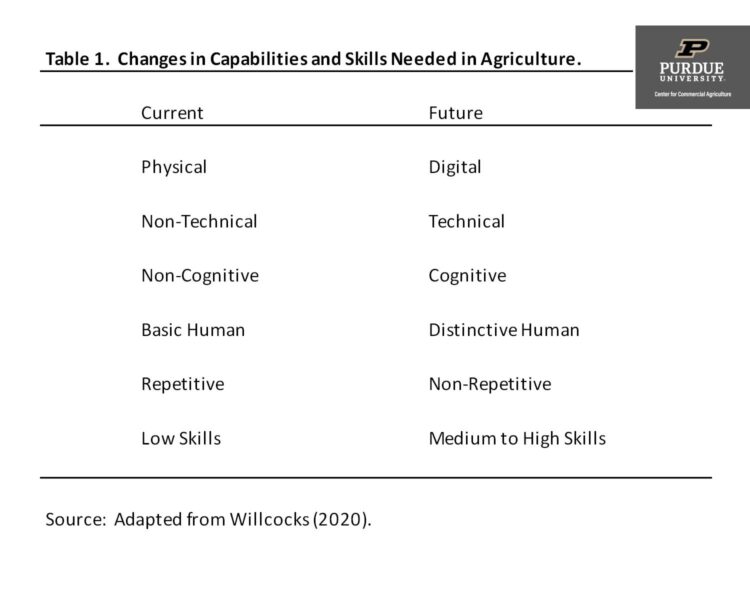April 15, 2021
What Will Be the Capabilities and Skills Needed to Manage the Farm of the Future?
by: Michael Langemeier and Michael Boehlje
A recent article discussed a number of automation and precision agriculture
technologies that will be increasingly used in production agriculture. The adoption and use of these
technologies will require additional expertise and skills of managers and the workforce on the farm in the
future. This article explores the capabilities and skills that may be needed to manage automation and
precision agriculture technologies, and provides a list of options for farms to build the workforce of the
future.
Staffing and Managing the Workforce
Even though the quantity of labor used in production agriculture has been declining for decades,
improving labor efficiency and finding the “right people” for the “right jobs” remains imperative to the
success of farms and ranches. In general, labor efficiency can be improved by investing in more capital
per worker and/or the adoption of less labor-intensive technologies. As a farm increases capital per
worker, particularly in today’s environment where many of the new technologies utilize automation, it is
important to assess whether the farm’s employees have the prerequisite capabilities and skills to fully
take advantage of new technologies. As noted by Langemeier and Boehlje (2017), technology is a key
driver influencing both financial performance and consolidation in production agriculture.
Precision farming will require a different (or at least enhanced) “mental model” of the farm manager and
farm workforce. Choosing and using precision farming tools and technologies requires an enhanced
appreciation and understanding of science and fact-based decision making. This includes a more
advanced understanding of the biological and physical sciences to frame these decisions, and the ability
to use data analytics and quantitative analysis tools such as statistical analysis and optimization models
to make these decisions. It is thus essential to bring new capabilities and skills into the farm of the future.
Skill Assessment
One of the ways to get a handle on the farm’s ability and proficiency with regard to a skill set such as
working with new technologies is to perform a skill assessment, which simply stated is an evaluation of each individual’s ability to perform a specific skill or set of skills. A skill assessment measures what
employees can do, and does not distinguish whether those skills were obtained through education or
experience. Skill assessments are often used when recruiting, for career development, and when rapidly
adopting new technologies which require new skills, reskilling, or upskilling.
A couple of previous articles discussed production skills and management practice skills.
Langemeier (2018) noted the importance of using a suite of technologies that provides the most efficient
use of inputs; employing consultants to assist with difficult or complex production problems; and
identifying, monitoring, and benchmarking key production efficiency measures. Langemeier (2019)
discussed the importance of developing a strategic plan that identifies “strategic issues”. One of the
components of a strategic plan is a regular assessment of technology needs for the business and a
financial plan that examines how the business is going to pay for new technologies.
Skill Gaps
The emergence of precision farming and in particular automation technologies is rapidly changing the
nature of work for all businesses, including farms and ranches. To maintain a competitive advantage,
farm operators will need to take a more active role in identifying the capabilities and skills needed by the
business, and to develop mechanisms to recruit, train, and retain employees. As part of a skill
assessment, it is important to identify “gaps in capabilities and skills” and to determine how the business
is going to address these gaps. The discussion below will first discuss potential gaps in capabilities and
skills and then pose some potential responses to these gaps.
As noted by Manyika et al. (2017) and Willcocks (2020), automation could perform certain tasks at
medium to high performance. For example, general equipment and navigation, inspecting and
monitoring, basic data input and processing, and basic communication could be performed relatively well
with automation technologies. However, capabilities pertaining to creativity, leadership, complex
information processing and interpretation, and advanced IT skills and programming would be difficult to
emulate with automation technologies. In particular, tacit knowing or the fact that humans know more
than they can describe is problematic to automation (Polanyi, 2009). Obviously, tacit knowledge makes it
difficult to write code for machine learning.

Table 1. Changes in Capabilities and Skills Needed in Agriculture
Table 1 illustrates current capabilities and skills with potential future skills needed in production
agriculture. This table was adapted from Willcocks (2020). To summarize the table, skills related to
those that are difficult for machines to emulate (e.g., creativity, leadership, strategic positioning, and
interpretation of data and information from precision agriculture technologies) will be critical to the farms
in the future. Individual farms need to assess whether they have someone on board that has these
capabilities and skills. If they don’t, would it be possible to contract for these skills? More options related
to developing the workforce of the future are discussed below. From a time management standpoint, one
of the upsides of current trends in automation is that it may free up employees to spend more time on
their distinctive human capabilities and skills (e.g., interpretation of data and information from precision
agriculture technologies) rather than on predictable physical work, potentially augmenting labor
productivity.
In addition to discussing changes in skills needed in the workforce as businesses adopt automation
technologies, Bughin et al. (2018) describe potential changes in the business workforce environment and
options for companies to build the workforce of the future. Though the authors focus their discussion on
businesses with numerous employees, many of the concepts discussed also apply to small businesses.
In terms of the workforce environment, developing a mindset of life-long learning, stressing collaboration,
and making sure that we have personnel that are responsible for leadership tasks, for supervising and
training employees, and for developing a strategy to purchase and fully utilize precision agriculture
technologies is important. Options for building the workforce of the future include retraining current
employees, redeploying employees so that they can focus on future skills needed, hiring individuals with
specific automation skills, contracting with outside parties for a portion of the automation skills needed,
and removing skills that are not as pertinent as they have been historically. Even with a small workforce,
farms will likely use a combination of these options rather than just one of the options.
We would be remiss if we did not indicate that there is going to be substantial competition for individuals
with distinctive human capabilities and skills. Having these individuals in place or making sure that one of
the operators or employees has the necessary skills set is likely to be critical to a farm’s competitive
advantage. Thus, developing a plan to develop or obtain these skills from an outside party is very
important.
Concluding Comments
This article discussed the capabilities and skills that will be needed to manage the farm of the future. As
we have noted, production agriculture is changing very rapidly. Adopting precision farming and
automation technologies (e.g., robotics, drones, autonomous machines) will be critical to a farm’s
competitive advantage. Each farm needs to evaluate whether it has the workforce in place to take full
advantage of precision agriculture and automation technologies, or develop a plan to access these
capabilities and skills from an outside party.
_____________________________________________________________
References
Bughin, J., E. Hazan, S. Lund, P. Dahlstrom, A. Wiesinger, and A. Subramaniam. “Skill Shift: Automation
and the Future of the Workforce.” McKinsey Global Institute, Discussion Paper, May 2018.
Langemeier, M. “Assessing Production Management Skills.” Center for Commercial Agriculture, Purdue University, September 28, 2018.
Langemeier, M. “Assessing Management Practice Skills.” Commercial Agriculture, Purdue University, February 1, 2019.
Langemeier, M. and M. Boehlje. “Drivers of Consolidation and Structural Change in Production
Agriculture.” Economic Review, Federal Reserve Bank of Kansas City, Special Issue, 2017, pages 5-23.
Langemeier, M. and M. Boehlje. “Automation and Robotics in Production Agriculture.” Commercial Agriculture, Purdue University,, April 9, 2021.
Manyika, J., M. Chui, and M. Miremadi. A Future that Works. San Francisco: McKinsey and Company,
2017.
Polanyi, M. The Tacit Dimension. Chicago: University of Chicago Press, 2009.
Willcocks, L. “Robo-Apocalypse Cancelled?” Journal of Information Technology. 35(Issue 4, 2020):286-
302.
TEAM LINKS:
PART OF A SERIES:
RELATED RESOURCES
UPCOMING EVENTS
December 1 & 8, 2025
Join Purdue Extension for a two-part workshop designed to help you gain a clearer understanding of tax planning essentials. The first session on December 1 will focus on the fundamentals of farm taxes, with particular emphasis on strategies that can be used in a low net income year. The second session on December 8 will focus on key tax strategies and will allow plenty of time for questions. Registration cost is only $20.
Read MoreDecember 15, 2025
This program provides in-depth coverage of agricultural and farm tax issues. In addition to covering timely tax issues, we will cover disaster tax issues, depreciation and expensing farm assets, retirement planning for farms, and tax planning in low-income years. This year’s webinar will be co-taught by a team from Ohio State and Purdue Universities.
Read MoreJanuary 27 or 28, 2026
Farm Shield is more than a conference, it’s a commitment to helping agricultural families build resilience and plan for a secure future. Don’t miss this opportunity to protect your legacy!
Read More

